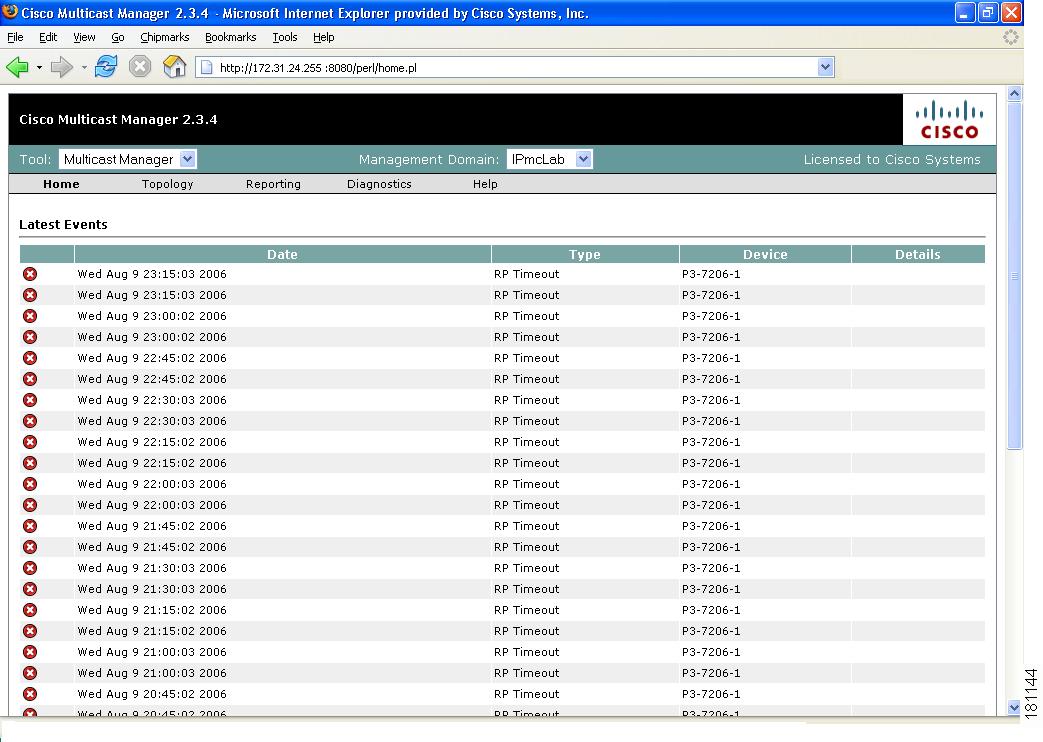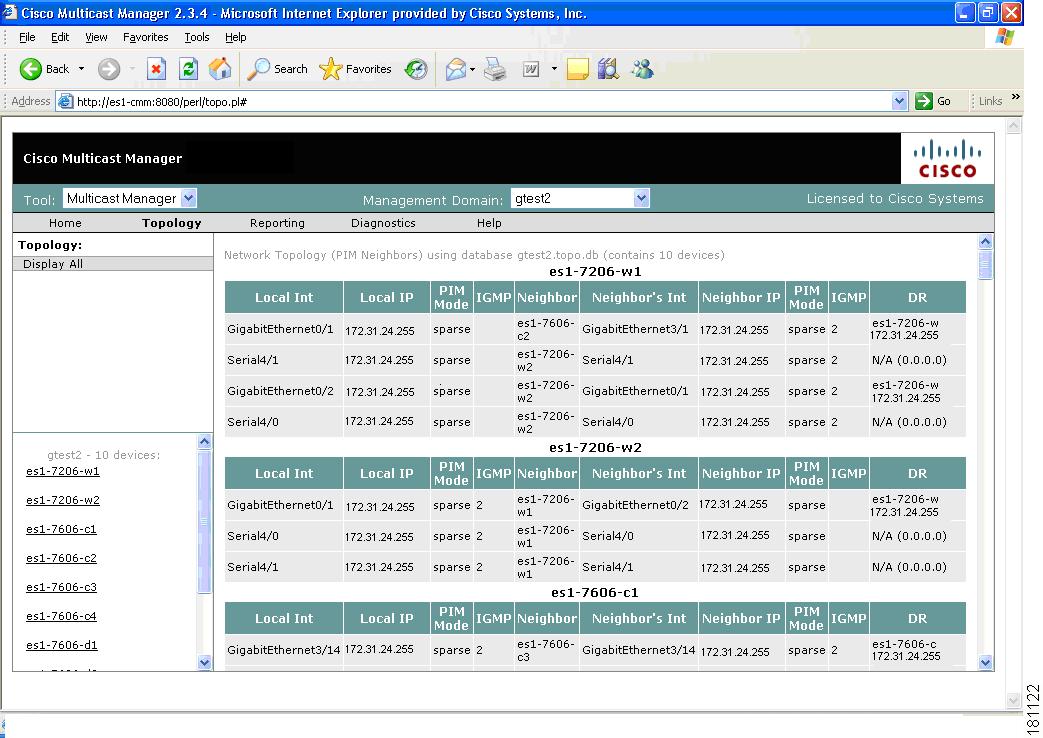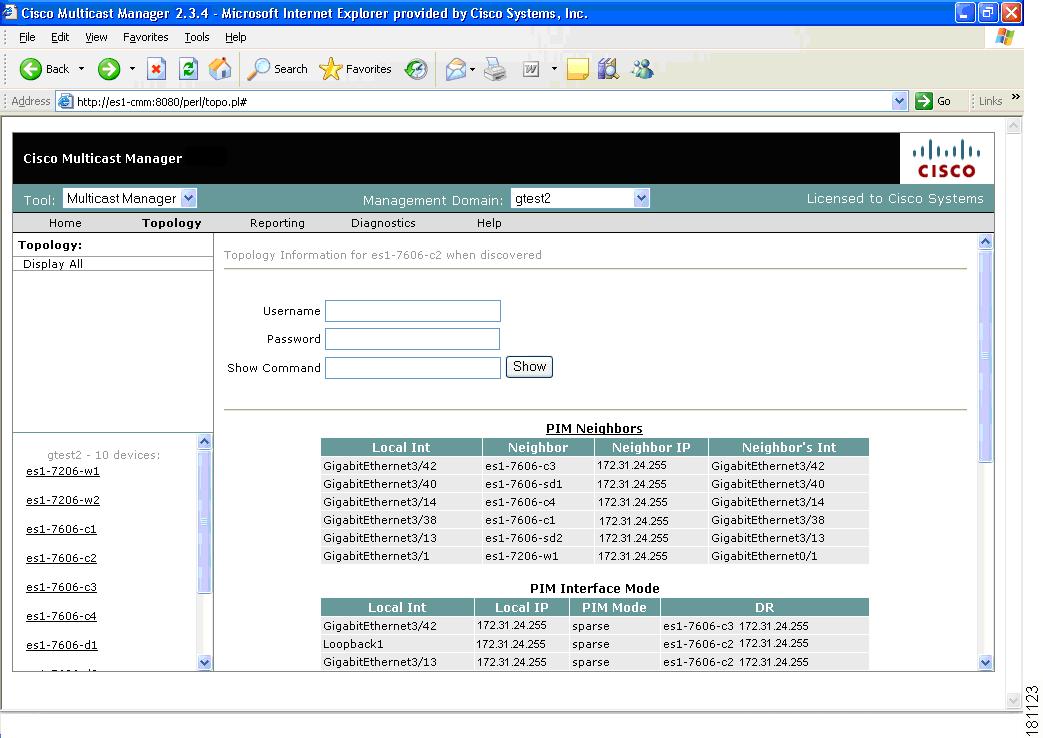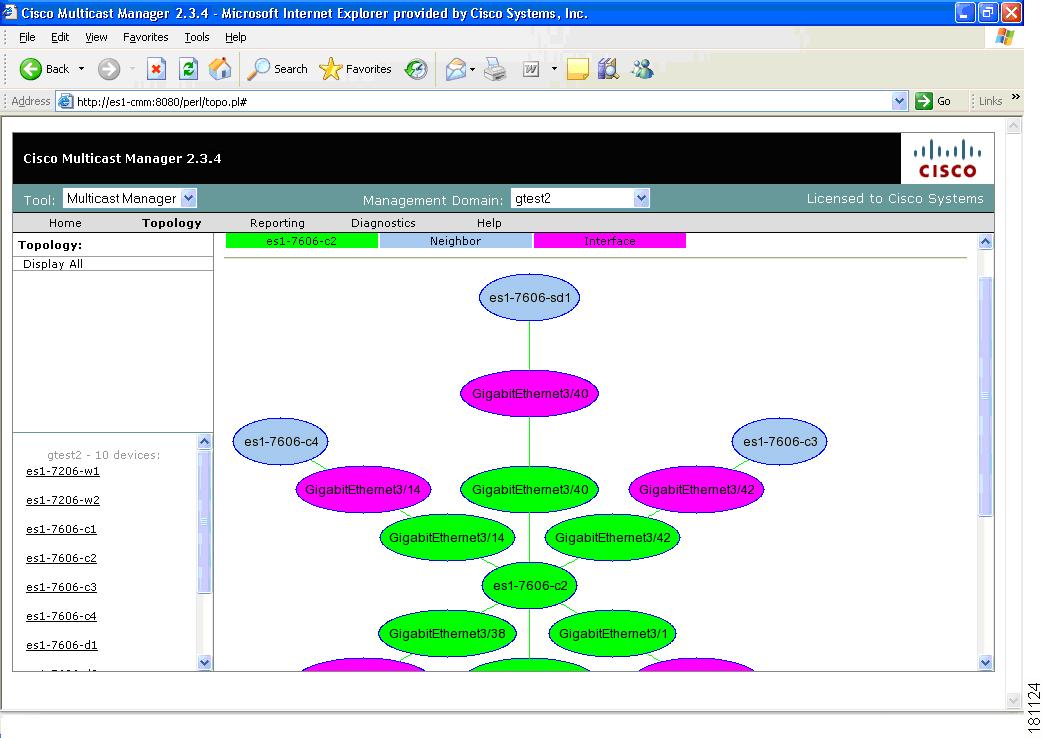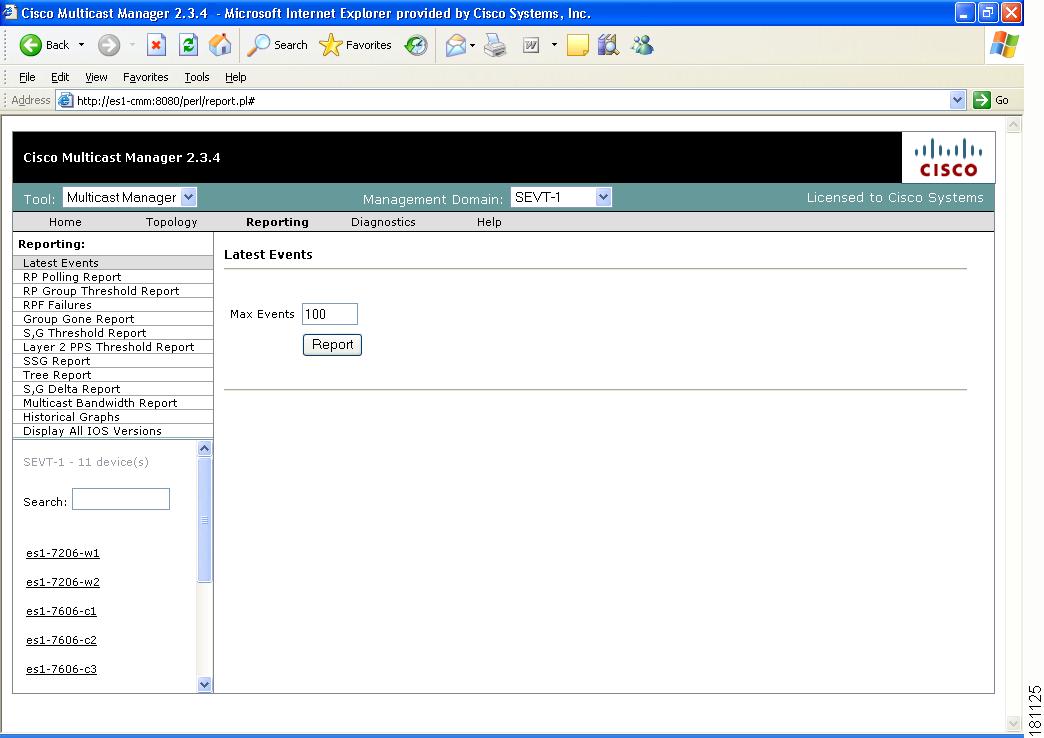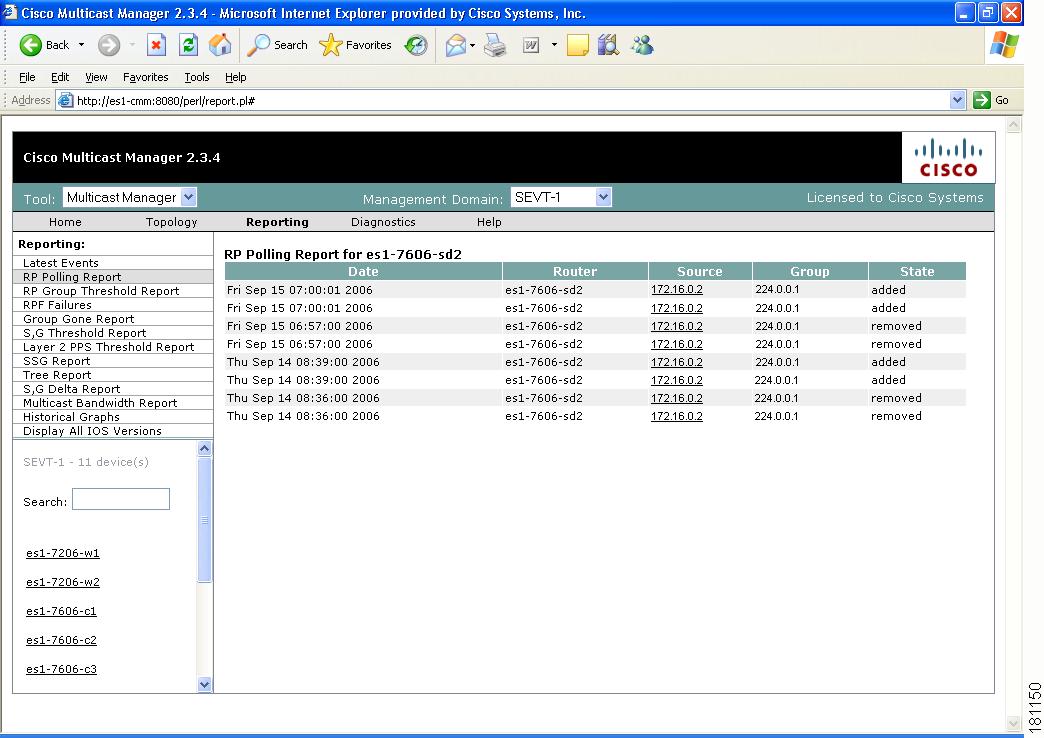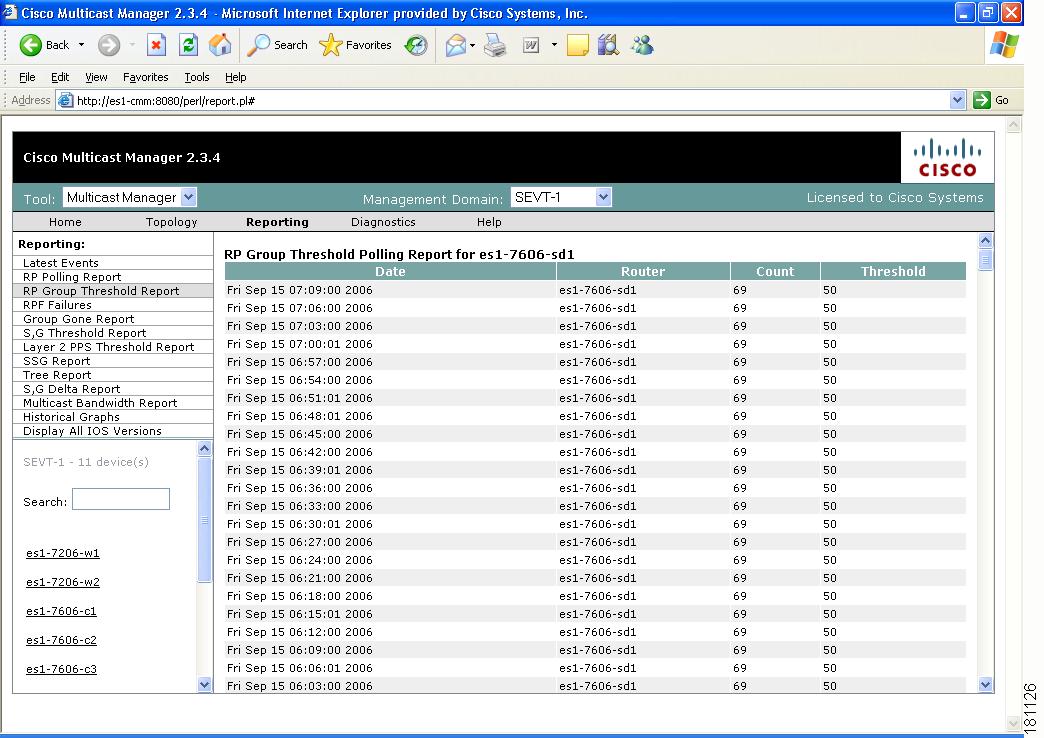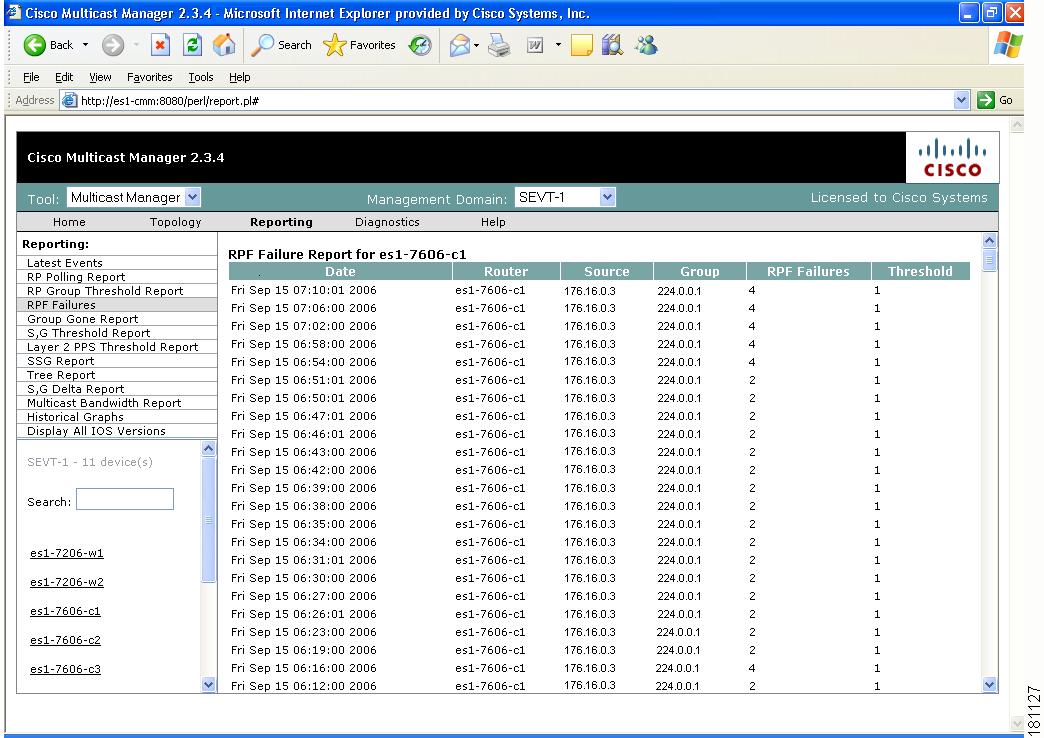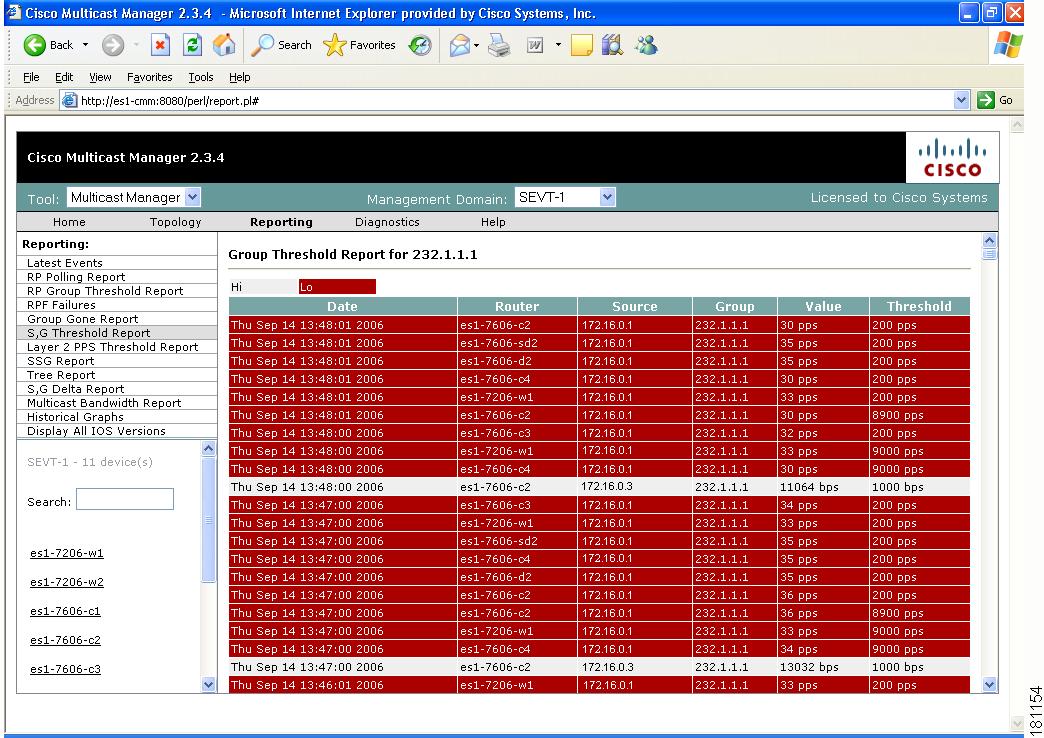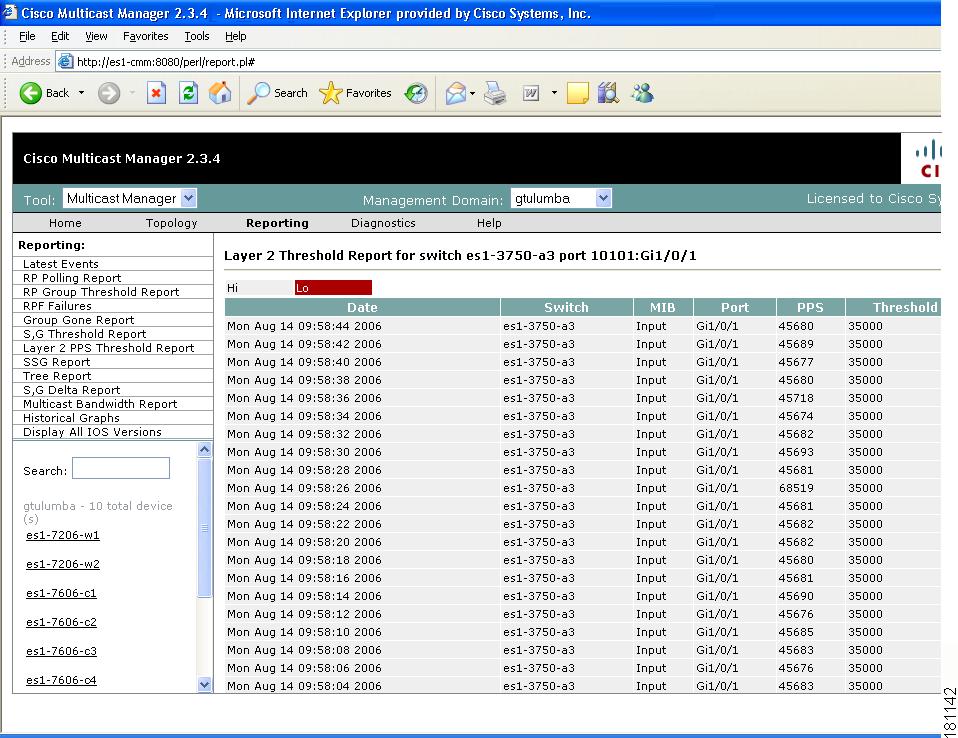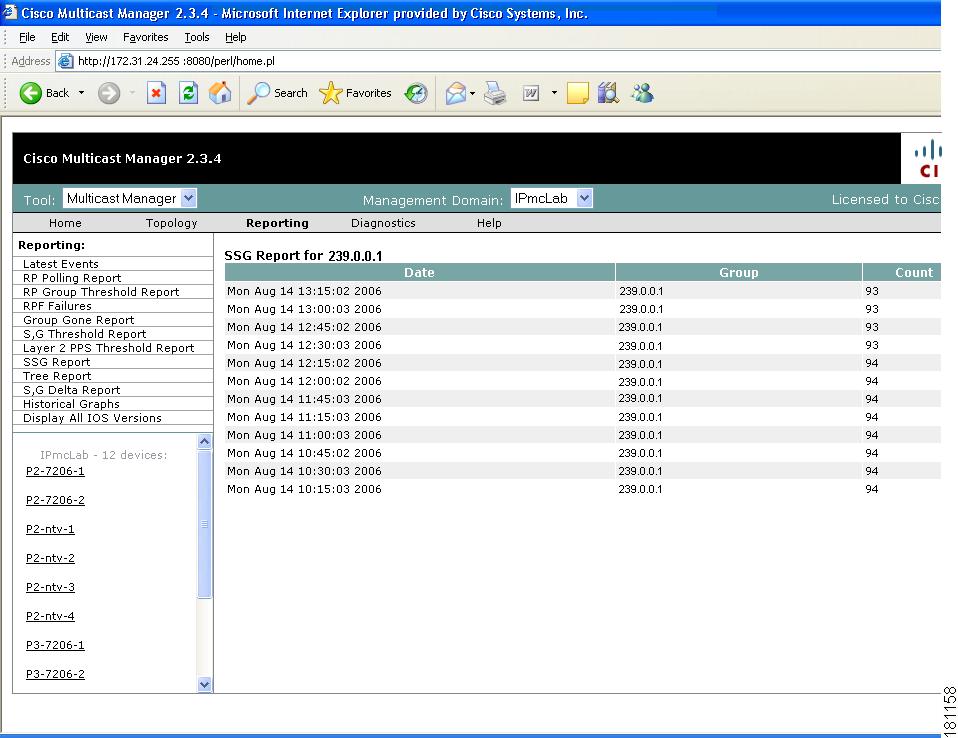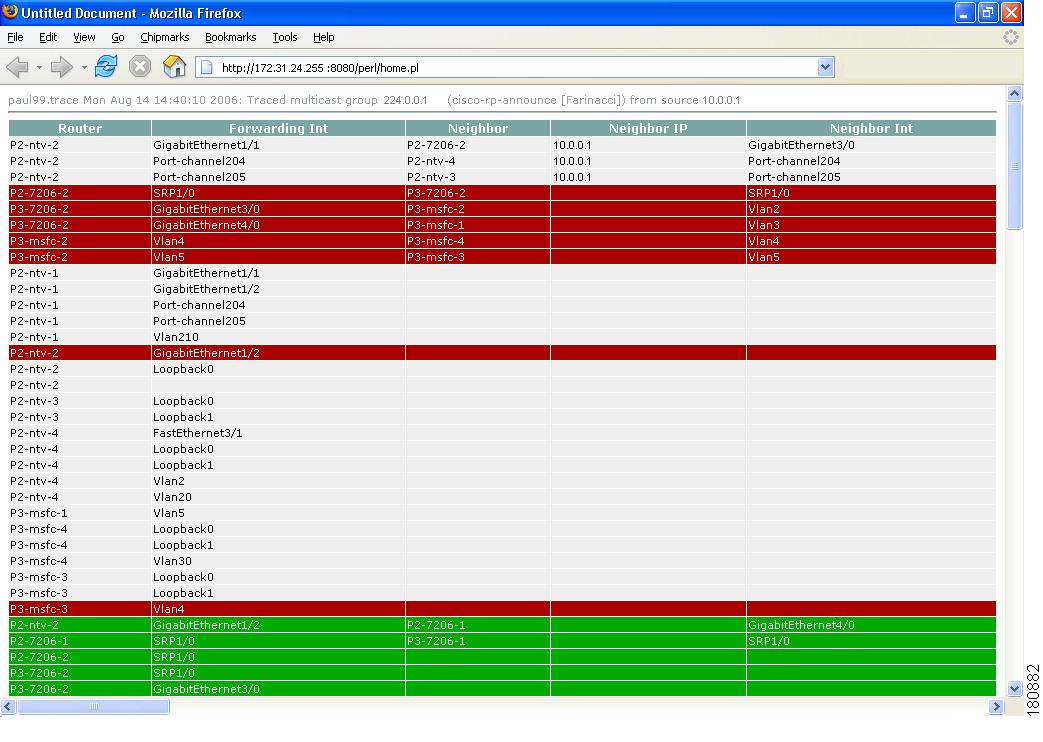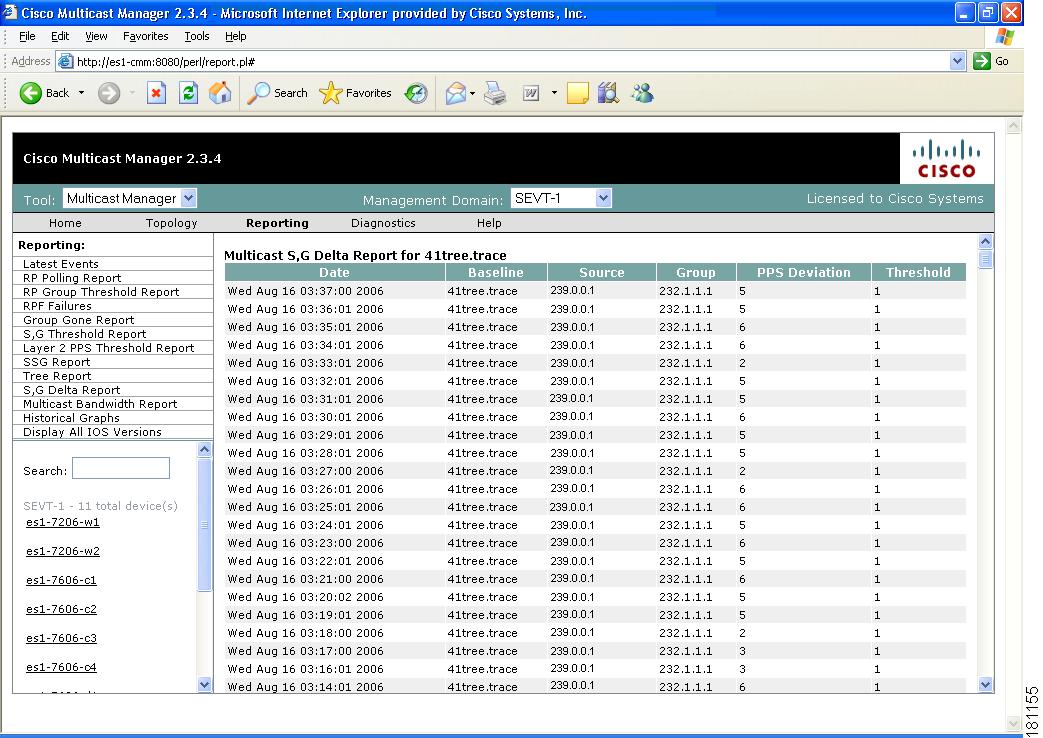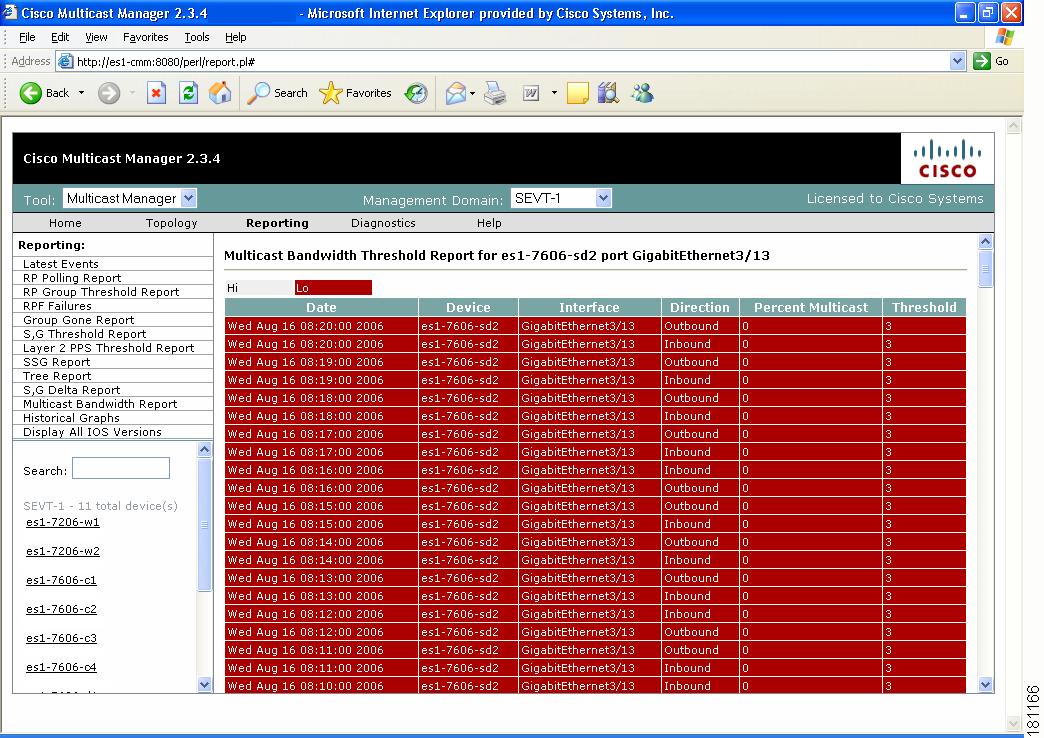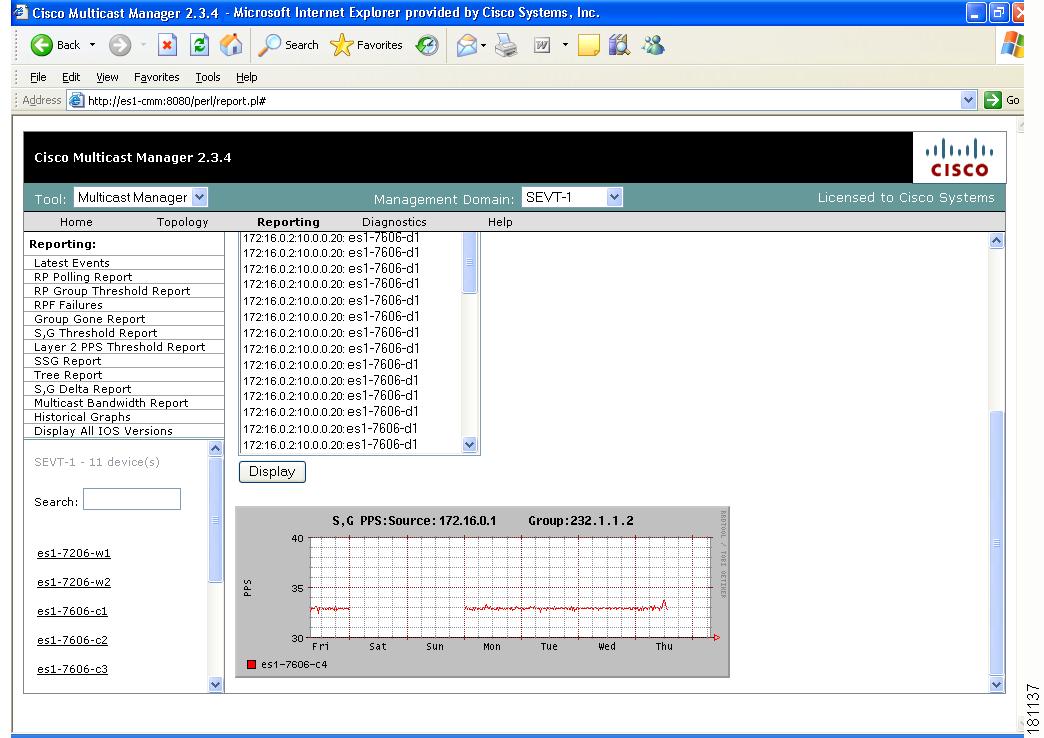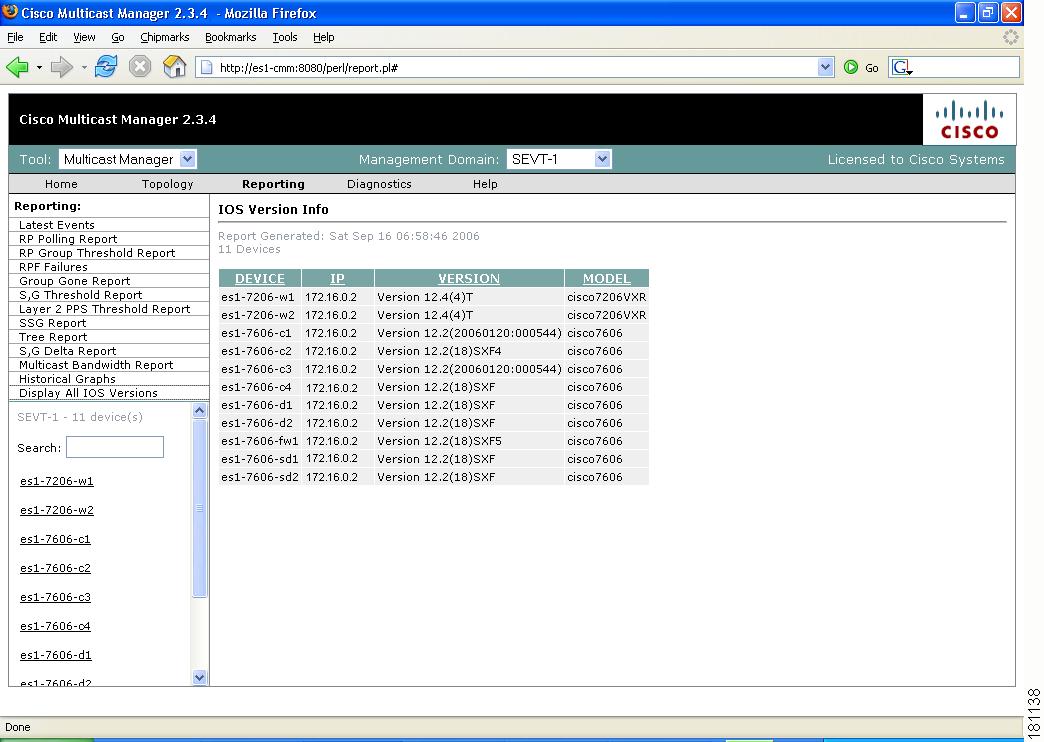

Table Of Contents
Monitoring with the Multicast Manager Tool
Viewing the Multicast Manager Home Page
Monitoring with the Multicast Manager Tool
This chapter covers:
•
Viewing the Multicast Manager Home Page
Viewing the Multicast Manager Home Page
When you log into the CMM, the Multicast Manager Home Page opens. To access this page from within the CMM, select the Multicast Manager tool, then select Home.
The Home page shows the last 20 events (see the "Latest Events" section).
Figure 3-1 Multicast Manager Home Page
Viewing Topology
Using Topology, you can display routers and their multicast information in the database, on an individual basis, or by showing the complete database.
To see the complete database, select Display All. Router names appear at the top of each table.
Figure 3-2 Topology Display All
To see topology for an individual router, click a router from the list pane at lower left.
Figure 3-3 Topology for an Individual Router
Note
For details on the table columns within this window, see the descriptions for the Topology Display All window.
To see a topological display of the routers, select PIM Neighbors.
Figure 3-4 PIM Neighbors
On the PIM Neighbors page:
•
Green = Router that was selected and its local interfaces
•
Purple = PIM neighbor's interfaces of this router's PIM neighbors
•
Blue = Names of the PIM neighbors of the selected router
Managing Reports
To start managing reports, within the Multicast Manager tool, click on Reporting.
Within Reporting, you can view:
•
A record of the latest SNMP traps sent
•
Historical graphs or trends
•
Routers in the database IOS versions
Note
The information shown for each type of report, with the exception of Historical Graphs, spans only the previous 24 hours. There may be more information available in the log file. However, it is recommended that the events.log file be rotated every 24 to 48 hours, depending on event activity.
Latest Events
Using the Latest Events page, you can set a configurable amount of the latest events generated by the CMM. Clicking Report lists the traps in time order.
Figure 3-5 Latest Events
RP Polling Report
Using the RP Polling Report, you can monitor:
•
All leaves and joins for the selected RP (if the Enable RP Add/Delete Traps option is selected, see the "RP Polling" section).
•
If the selected RP becomes unavailable.
•
Any rogue source or group that joins the selected RP.
To generate an RP Polling report:
Step 1
Select an RP from the list.
Step 2
You can specify the maximum number of events to display.
Step 3
Click Report. The report contains any events that have occurred in the last 24 hours.
Figure 3-6 RP Polling Report
RP Group Threshold Report
Using the RP Group Threshold Report, you can monitor a list of RPs that have exceeded their active number of groups limit.
To generate an RP Group Threshold report:
Step 1
Select an RP from the list.
Step 2
You can specify the maximum number of events to display.
Step 3
Click Report. The report contains any events that have occurred in the last 24 hours.
Figure 3-7 RP Group Threshold Polling Report
RPF Failures
Using the RPF Failures Report, you can monitor all routers that are experiencing RPF failures above the configured threshold for the configured sources and groups.
To generate an RPF Failures report:
Step 1
Select an RP from the list.
Step 2
You can specify the maximum number of events to display.
Step 3
Click Report. The report contains any events that have occurred in the last 24 hours.
Figure 3-8 RPF Failures Report
Group Gone Report
The Group Gone Report is currently unsupported. Functionality in this page has moved to the S,G Polling Report.
S,G Threshold Report
Using the S,G Threshold Report, you can monitor every source and group that has exceeded its configured threshold.
To generate an S,G Threshold report:
Step 1
Select a group from the list.
Step 2
You can specify the maximum number of events to display.
Step 3
Click Report. The report contains any events that have occurred in the last 24 hours, and shows pps and bps.
Figure 3-9 S,G Threshold Report
Layer 2 PPS Threshold Report
Using the Layer 2 PPS Threshold Report, you can monitor all Layer 2 ports that have exceeded their configured thresholds.
To generate a Layer 2 PPS Threshold Report:
Step 1
Select a switch from the list.
Step 2
Select a port from the list.
Step 3
Click Select. The report contains any events that have occurred in the last 24 hours.
Note
The report is for inbound and outbound traffic on the port.
Figure 3-10 Layer 2 PPS Threshold Report
SSG Report
Using the SSG Report, you can display information about groups that have more than one sender.
To generate an SSG Report:
Step 1
Enter the multicast group address.
Step 2
Click Report. The report contains any events that have occurred in the last 24 hours. The count indicates the number of sources sending to the group.
Figure 3-11 SSG Report
Tree Report
Using the Multicast Tree Report, you can draw and save multicast trees (called baselines). You can then set up the CMM to draw trees that have been saved in the background, and report any changes. (Only changes to Layer 3 devices are reported.)
Note
The drawing and saving of trees is covered in Show All Groups.
If a multicast tree you are monitoring changes, a trap is generated. You can then view the baseline and the changed tree. Changes are highlighted in the text and also in the drawing.
To generate a Multicast Tree Report:
Step 1
Select a baseline (multicast tree) from the list.
Step 2
You can specify the maximum number of events to display.
Step 3
Click Select. The report contains any events that have occurred in the last 24 hours.
Figure 3-12 Tree Report
Selecting "trchanged" in the third column in the report will graphically show the baseline, along with the changed tree. Changes to the tree are highlighted in the table at the top as shown in the figure. The baseline and the current tree are also shown graphically.
Figure 3-13 Tree Report Page—trchanged
S,G Delta Report
Using the Multicast S,G Delta Report, you can view information about PPS rate deviation on multicast trees.
To generate a Multicast S,G Delta Report:
Step 1
Select a baseline (multicast tree) from the list.
Step 2
You can specify the maximum number of events to display.
Step 3
Click Select. The report contains any events that have occurred in the last 24 hours.
Figure 3-14 Multicast S,G Delta Report
Multicast Bandwidth Report
To generate a report for a router interface that has exceeded its multicast bandwidth thresholds:
Step 1
Select the device.
Step 2
Select the port.
Step 3
Select the maximum number of events.
Step 4
Click Report.
Figure 3-15 Multicast Bandwidth Threshold Report
Historical Graphs
Using Historical Graphs, you can view historical data in a graph format. Historical data is collected when you start to monitor any of the following:
•
Source and group activity in a router
•
Multicast packets inbound or outbound of a Layer 2 port
•
Source and group packet deviations on baseline multicast trees.
To view Historical Graphs:
Step 1
Select a Graph Type from the list:
•
SG Delta PPS
•
SG PPS
•
SG BPS
•
Switch Port PPS
Step 2
Select a Time Range:
•
User Specified
•
Hour
•
Day
•
Week
•
Month
Then select a Start and End range.
Step 3
A list of available reports appears. Highlight the appropriate report(s) and click Display. You can select up to 3 reports to display on the graph. Data stored for trending purposes is kept for up to 18 months.
Note
Data must be collected to generate a report. If you have selected the correct Graph Type, and you do not see any entries, ensure that data is being collected (see Top Talkers).
Figure 3-16 Historical Graphs
Display All IOS Versions
Using the IOS Version Info page, you can view the IOS version of all discovered routers in the current domain. You can sort the table by device, IP address, IOS version, or model by selecting the corresponding column heading.
Figure 3-17 IOS Version Info

 Feedback
Feedback